| By: Paul S. Cilwa | Page Views: 5581 | ||
| There exist ancient documents that tell us exactly how our species came to be, and modern science backs it up. | |||
Have Aliens Ever Visited Earth?

If Earth is being visited by extraterrestrials now, as many insist, then the question arises: Have
extraterrestrial aliens ever visited Earth in the past? If so, have they left evidence of their presence?
If the answer is yes,
then the current visitations become easier to believe;
and, if the visits have been made by the same aliens, then perhaps the purpose of the
present encounters can be determined.
Back in the '60s, the author Erich von Daniken made headlines with his book,
Chariots of the Gods, and its sequels, in which he presented a huge amount of evidence that he
claimed proved aliens had visited Earth in the past. This evidence included anachronistic
metals, devices, and common myths. Von Daniken's work was marred by two flaws. First, he
had a tendency to make up facts
when he couldn't find the ones he wanted.
Second, his evidence really only proved that a superior technology once existed on Earth,
not that it was necessarily alien. Many readers, therefore, were left with the conclusion
that von Daniken had unintentionally proven the existence of Atlantis!
The fact is, however, that aliens have visited Earth…and have left behind, not just a trinket or two, but volume after volume of written evidence, in the form of clay tablets left behind in the ruins of Sumer, Earth's first historical civilization.
The Earth Chronicles
No one suspected the existence of the Sumerian people and language before the mid-19th century CE. The first major excavations leading to the discovery of Sumer were conducted between 1842-54 at Assyrian sites such as Nineveh, Dur Sharrukin, and Calah by the French archaeologists Paul Émile Botta and Victor Place; the British archaeologists Sir Austen Henry Layard and Sir Henry Creswicke Rawlinson; and the Iraqi archaeologist Hormuzd Rassam. Thousands of tablets and inscriptions dating from the 1st millennium BCE, the vast majority written in Akkadian, were uncovered.

If these tablets and illustrated cylinder seals had been first viewed today, we would
immediately recognize the pictures of spacecraft, aircraft, radiation treatments, and
astronomical data. However, the best minds of the 1850s could not imagine such things, and
certainly not in relation to a long-dead civilization. They did the best they could in
translating the ancient texts, but found many concepts that defied their imaginations.
When confronted with a text, for example, that stated a person was going to make a
something that would raise him or her above everyone and everything else in the world,
that something was translated name.
The original word,
shem, actually means spacecraft; but who in the 19th century could have guessed that?
It wasn't until Zecharia Sitchin came along with a fresh eye that the texts were revealed in their true meaning.
Sitchin's basic premise is that the Sumerians, who claimed to have been created by a
race of gods
from another planet in this Solar System, were correct. This
premise is easily tested; if the Sumerians were, indeed, given knowledge by advanced
aliens, that knowledge should be more correct than otherwise possible…and, sure enough,
their astronomical tables include accurate orbital information for all the planets,
including Uranus, Neptune, and even Pluto—the three planets of our Solar System that are
not visible to the naked eye. (They were not re-discovered until 1781, 1846, and 1930,
respectively.) Even the major moons of Jupiter, re-discovered by Galileo in 1610, were
known to the Sumerians!
This proof of their scientific knowledge demands that we take their other stories, if not at face value, at least with an open mind and willing attitude.

According to the Sumerians, the gods
were beings who looked much like us
(we were created in their image
) but came from a world far from the Sun, that
they called Nibiru. In Sumerian, NI.BI.RU means planet of the crossing;
they
named their world that because, every 3600 years, it crossed from the outer depths of the
Solar System into its inner reaches—it had, in other words, an extremely elliptical
orbit, like that of a comet.
On May 28, 1998, the Hubble Telescope team reported that the first image of a possible, extra-solar planet had been taken. The planet, called TMR-1C, had apparently been ejected from its star at high speed. If such occurrences are common, then it becomes less unlikely that Nibiru might, also, have been an ejected planet that drifted through insterstellar space until it fell into our Solar System.
Some 450,000 years ago, according to the Sumerians' timeline, a Nibiruan fled from his home world to Earth. Nibiru was having some sort of environmental crisis at the time, which required finely ground gold dust to rectify. When this Nibiruan, called Alalu, discovered that Earth was rich in the yellow metal, he put aside past differences and contacted his home world.
Within five thousand years, the Nibiruans (who are extremely long-lived and move with
glacial deliberation) were able to mount a massive space program and send 500 astronauts
to Earth to extract gold from the waters of what is now the Persian Gulf. These
astronauts, the Anunaki (meaning, Those Who To Earth From Heaven Fell
),
are the giants
of the Old Testament, the Sons of God
who married
the daughters of men.
However, that is getting 'way ahead of the story; for,
according to the Sumerians, Humankind had not yet been created.
(In fact, man had been created; we have fossils of Neanderthals dating from this period. Neanderthals lived the lives of simple hunter/gatherers, as we know by examining the caves in which they lived and studying their tools and their remains. They buried their dead with weapons and jewelry, which no other Earth animal does, implying they had some sort of belief regarding an afterlife. Still, they had no cities, did not farm or domesticate animals, and lived in an unchanging culture—their tools did not change over the hundreds of thousands of years they roamed the ancient stone age world.)
By 416,000 years ago, it became evident to the Nibiruans that extracting gold from seawater was too inefficient a process to save their home world in time, and the order came to mine it instead. (There are, in fact, the remains of extremely ancient gold mines in South Africa, whose age defies analysis.) The Anunaki, hired to be spacemen and lab techs, found themselves pressed into service as miners. The work was hard and intolerable to them; still, in true Nibiruan fashion, they endured it for well over 100,000 years before mutinying.
In response to the mutiny, a Nibiruan named Ninhursag used genetic manipulation to
combine the genes of ape-woman
(probably Homo Erectus) and Nibiruans
to produce Man (Cro-Magnon, or anatomically modern, Humans). This happened, according to the
Sumerians, about 300,000 years ago somewhere near Africa's Rift Valley. Until recently,
this date would have sounded much too soon for the appearance of modern Humans; but recent
finds of extremely old anatomically-modern Human finds have made it plausible.

Specifically, 223 Nibiruan genes were spliced into those of Homo Erectus, creating a new species, Homo Sapiens. Biologists knew that most species on earth differ from each other by only one (and sometimes, in closely-related species, zero) genes; the differences being expressed by varying spaces between the genes. That's why all vertebrates have the same basic skeletal structure—the giraff has exactly the same number of bones in its necks as do you and I. 223 genes isn't a lot, compared to the total number. Before the completion of the human genome project, many scientists were expecting to find 100,000 or more genes in our genome. This was based on the assumption that because we are one of the most complex creatures on Earth we should have lots of genes. However, it turned out we only have around 24,000 genes. But where zero genes separate horses and zebras, 223 genes separate us from our nearest living relatives, the bonobo chimp.
At first, the genetically altered Humans were sterile and had to be artificially
carried to term by Nibiruan birth goddesses,
chosen from among the Anunaki,
who apparently found that type of labor to be preferable to working in the mines.
Obviously, though, this means of producing workers was inherently inefficient. Enki, the
Nibiruan whose idea all this was, broke ranks and secretly further manipulated the workers'
DNA, making it possible for them to procreate.
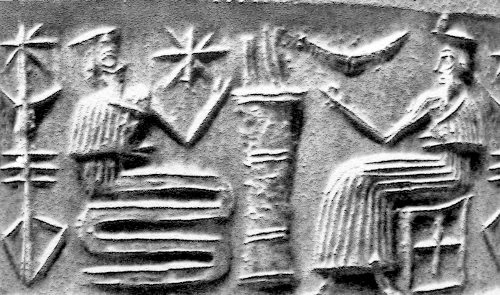
An amazing aspect of this story is that the first workers were given the task of
tending a garden. Where was it? The Sumerian name was…E.DIN! What's more, the Tree
of Knowledge
takes on special significance when we remember that knowing
is a Biblical euphemism for having sex…and when we find out that Enki's
trademark
or symbol was…the serpent!
By 100,000 years ago, Humankind's place in this colony world of Nibiru seemed secure.
Many of the Anunaki—called nefilim in Hebrew, and translated
giants
in the King James Version of The Bible—took for themselves wives and husbands from
among the Humans; the job of genetic manipulation had been so thorough that the mixed
couples could even bear children. This practice was looked upon by the Nibiruan leaders
with alarm, however. Some also doubted the use of another species for service was good for
the Nibiruans' own welfare. Some Nibiruans began to wonder if it might ever be possible to
close this particular can of worms.
The Flood

By 75,000 years ago, the most recent ice age gripped Earth. It was fourth in a series, but the first in the Nibiruans' experience. Sea levels fell; once-lush areas became deserts; temperatures dropped. The glaciers of the world grew, and grew, and grew. By about 13,000 years ago, the seas had fallen to 200 feet below their present level, and the glaciers covering Antarctica had reached critical mass. Almost any celestial jiggling could send them plunging into the oceans; and one was on its way: Nibiru, approaching from its eccentric orbit, was about to pass near Earth on its 3600-year orbit.
It was not hard for Nibiruan scientists to calculate that the collapsing ice shelves of Antarctica would produce a world-wide tsunami, or even when; the Nibiruans were hastily called into orbit, forced to leave their Human husbands and wives, even prevented by oath from warning them of what was about to befall. One Nibiruan, however—our friend, Enki—told his favorite Human anyway. That Human, known as Ziasudra to the Sumerians and Noah to the Hebrews, was instructed to build a submersible vessel and to wait there with his family and with the genetic samples of all Earthly animals and pairs of animals of various genera to serve as surrogate parents so that Earth's fauna could be restored after the deluge.
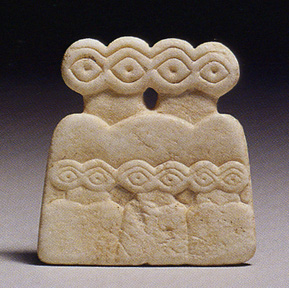
The igigi, Nibiruan astronauts who maintained an orbiting space station, were not prepared to support hundreds of displaced Anunaki; food supplies ran low and it was a hungry group of Nibiruans who landed on the soggy Earth after many weeks of flood. They might well have been upset to find surviving Humans…if the Humans hadn't had food with them. The Anunaki, even Enki's (and our) nemesis Enlil, grudgingly decided that the Nibiruan/Human alliance was here to stay.
Nibiruans could only commute to and from their home world when it was near
the Sun—otherwise, it was just too long a journey. That happened every 3600
years. In each of the next few of these Nibiruan years, according to the Sumerian sources, Humans were
given
new technologies: First, agriculture; then, domesticated animals that
provided Humans with servants as Humans served the Nibiruans. Finally, cities were
introduced as support for armies of Nibiruans, as individuals fought for control and
position.
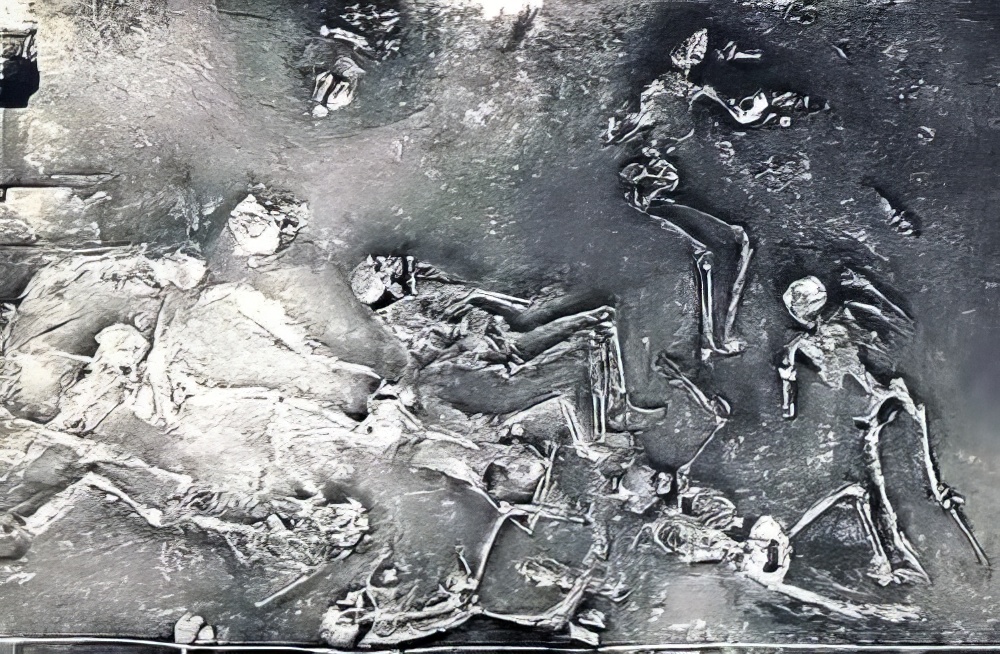
The Sumerians recorded the loosening of buried gold by the Deluge, so that placer
mining could be conducted in South America (and South American records bear out the
visitation of bearded white men from the East). They recorded the Pyramid Wars, and even
described the granite plug found in the Great Pyramid and explained why no mummies were
ever found in these supposed tombs.
They described the result of nuclear
fallout on the cities of their civilization (and the remains of cities have been found
there that were chopped off at the foundation,
all walls smashed in the same
direction, as would happen in a nuclear blast).
By 2023 BCE, the winds carried the radioactive cloud to Sumer. People died a terrible death; animals perished; the water was poisoned; the soil became barren. Sumer and its great civilization lay prostrate. Its legacy passed to Abraham's seed as he begot—at age 100—a legitimate heir: Isaac.
The God of Abraham

In many ways, the god of Abraham was different from the gods
who preceded him, the
Nibiruans who had tinkered so fatefully with Humankind. For one thing, he was invisible:
The Nibiruans, at least at first, had worked face-to-face and side-by-side with their
Human servants. Yahweh, as he called himself when Moses asked, was never to be seen. For
another thing, the Nibiruans had never been shy about posing for statues and other
illustrations. Yahweh refused to allow any images of himself. Also, alone among all the gods,
Yahweh was not married and was not even involved in any other of the dramatic love affairs
that so illustrated the morals
(or lack thereof) of the Nibiruans.
For these reasons, Sitchin proposed that Yahweh was not a Nibiruan…that, as the
Nibiruans were gods
to us, Yahweh was God to the Nibiruans, and he had gotten
tired of the way the Nibiruans were treating us, and had decided to take over.
Certainly, the Old Testament tells of Yahweh's people attacking the various remnants of Nibiruan-centered religion, until at last none remained.
But then, Yahweh seemed to leave us alone, making it seem as if his presence had merely been to build up an army and defeat the Nibiruans, much as the United States and the Soviet Union fought a war in the innocent (but oil-rich) country of Vietnam.
Where Did They Go?
If the Nibiruans spent so much time manipulating the affairs of Humans, literally half a million years…where did they go? Why haven't we heard from them since the time Yahweh played an active part in our development?
I see four possibilities.
-

They destroyed themselves. Certainly they had the power—nuclear bombs and other weapons of mass destruction—and they had the bad attitudes to use them. The Nibiruans had science and technology, but little self-restraint, a combination that our own recent close calls with nuclear weapons suggests could be deadly, indeed.
Yahweh destroyed them on their home world, as he managed to wipe them out on ours.
They decided to leave us alone. Perhaps they solved their ecological crisis and no longer needed Earth's gold. Perhaps Yahweh scared them away. Perhaps they developed a conscience in spite of themselves.
They are still here. Depending how Human they really look, they might be
immortals
living among us, thesecret government,
or even the aliens who abduct some of us now for—what else?—continuing genetic experimentation.
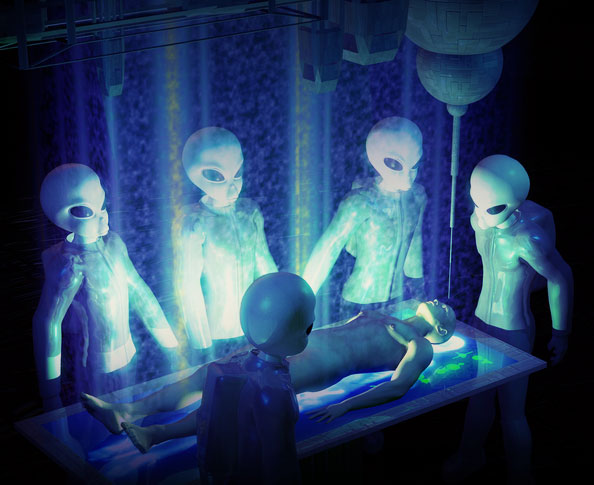
While the question of where they went is certainly of importance—especially if they are still here—another urgent issue is: What part of us is Earth, and what part Nibiruan? What parts were built into us for the Nibiruans' benefit, and not ours?
Bibliography
Books in the Earth's Chronicles series: (All Avon Books)
Companion Book: Genesis Revisited
Links
Lemuria
| By: Paul S. Cilwa | Page Views: 3670 | ||
| Second only to Atlantis, Lemuria has fascinated us with its mirror-tale of a sunken civilization. But Atlantis was described by Plato almost 2400 years ago; no one had ever heard of Lemuria until a fly fisherman wrote about it in 1926. | |||

In 1926, James Churchward, an author whose previously published work was one on fly-fishing in Maine, rocked the world with his claimed discovery of a lost continent and civilization. Called alternatively MU and Lemuria, this continent was supposed to have existed in the Pacific Ocean and been home to Humans for several millions of years before its sinking 13,000 years ago, when gas belts lying beneath it collapsed. (These same gas belts were supposed to have ignited elsewhere, forming mountains—according to Churchward, there were no mountains on Earth before 11,000 BCE.)
Read more…
The Case of the Missing Elephant
| By: Zecharia Sitchin | Page Views: 3815 | ||
| Were the ancient Olmecs really Africans, and, if so, what were they doing in South America? | |||
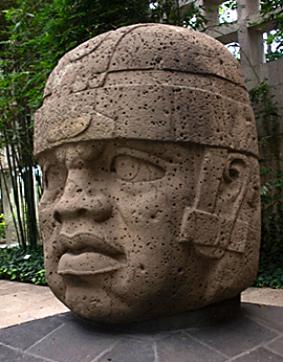
The ruins and remains of Mexico's pre-Columbian civilizations enchant, intrigue, fascinate and puzzle. Of them the oldest and earliest, that of people referred-to as Olmecs, is the most enigmatic — for they challenge present-day scholars to explain how had people from Africa come and settled and thrived in this part of the New World, thousands of years before Columbus.
Read more…



